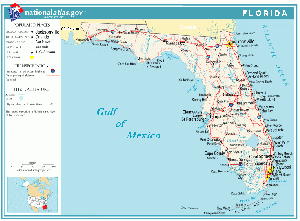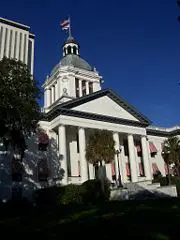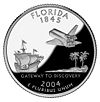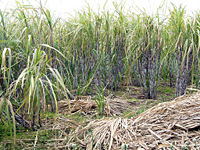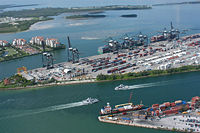Difference between revisions of "Florida" - New World Encyclopedia
Vicki Phelps (talk | contribs) m (→Economy) |
Vicki Phelps (talk | contribs) |
||
| Line 135: | Line 135: | ||
| − | |||
| − | |||
| − | |||
| − | |||
| − | |||
| − | |||
| − | |||
| − | |||
| − | |||
| − | |||
| − | |||
| − | |||
| − | |||
| − | |||
| − | |||
| − | |||
| − | |||
| − | |||
| − | |||
| − | |||
| − | |||
| − | |||
| − | |||
| − | |||
| − | |||
| − | |||
| − | |||
| − | |||
| − | |||
| − | |||
| − | |||
| − | |||
| − | |||
| − | |||
| − | |||
| − | |||
| − | |||
| − | |||
| − | |||
| − | |||
| − | |||
| − | |||
| − | |||
| − | |||
| − | |||
| − | |||
| − | |||
| − | |||
| − | |||
| − | |||
| − | |||
| − | |||
| − | |||
| − | |||
| − | |||
| − | |||
| − | |||
| − | |||
==Government== | ==Government== | ||
Revision as of 16:35, 3 October 2008
Template:US state
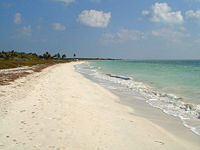
The State of Florida is located in the southeastern region of the United States. Most of the state is a large peninsula with the Gulf of Mexico on its west and the Atlantic Ocean on its east. Florida is the fourth most populated state in the country, behind California, Texas, and New York.[1]
Geography
Florida is situated mostly on a large peninsula between the Gulf of Mexico, the Atlantic Ocean, and the Straits of Florida. It extends to the northwest into a panhandle, extending along the northern Gulf of Mexico. It is bordered on the north by the states of Georgia and Alabama, and on the west, at the end of the panhandle, by Alabama. It is near the countries of the Caribbean, particularly the Bahamas and Cuba.
Florida is one of the largest states east of the Mississippi. Only Alaska and Michigan are larger in water area.
The Florida peninsula is a porous plateau of karst limestone sitting atop bedrock. Extended systems of underwater caves, sinkholes and springs are found throughout the state and supply most of the water used by residents. The limestone is topped with sandy soils deposited as ancient beaches over millions of years as global sea levels rose and fell. During the last Ice Age, lower sea levels and a drier climate revealed a much wider peninsula, largely desert. At the southern end of the peninsula, the Everglades are in fact an enormously wide, very slow-flowing river.

At 345 feet (105 m) above mean sea level, Britton Hill is the highest point in Florida and the lowest high point of any U.S. state.[2]Much of the interior of Florida, typically 25 miles (40 km) or more away from the coastline, features hills with elevations ranging from 100 to 250 feet (30 – 76 m) in many locations.
Climate
The climate of Florida is tempered somewhat by its proximity to water. Most of the state has a humid subtropical climate, except for the southern part below Lake Okeechobee, which has a true tropical climate.[3] Cold fronts can occasionally bring high winds and cool to cold temperatures to the entire state during late fall and winter. The seasons in Florida are determined more by precipitation than by temperature with mild to cool, relatively dry winters and autumns (the dry season) and hot, wet springs and summers (the wet season). The Gulf Stream has a moderating effect on the climate, and although much of Florida commonly sees a high summer temperature over 90°F (32°C), the mercury seldom exceeds 100°F (38°C). The Florida Keys, being surrounded by water, have a more tropical climate, with less variability in temperatures.
Although Florida's nickname is the "Sunshine State," severe weather is a common occurrence. Central Florida is known as the lightning capital of the United States, as it experiences more strikes than anywhere else in the country. Florida has the highest average precipitation of any state, in large part because afternoon thunderstorms are common in most of the state from late spring until early autumn. These thunderstorms, caused by collisions between airflow from the Gulf of Mexico and airflow from the Atlantic Ocean, pop up in the early afternoon and can bring heavy downpours, high winds, and sometimes tornadoes. Florida leads the United States in tornadoes per square mile, but these tornadoes do not typically reach the intensity of those in the Midwest and Great Plains. Hail often accompanies the most severe thunderstorms.
Snow is a rare occurrence. During the Great Blizzard of 1899, Florida experienced blizzard conditions. The most widespread snowfall in Florida history happened on January 19, 1977, when snow fell over much of the state in different times of the month. Snow flurries fell on Miami Beach for the only time in recorded history.
Although some storms have formed out of season, tropical cyclones pose a severe threat during hurricane season, which lasts from June 1 to November 30. Florida is the most hurricane-prone US state, with subtropical or tropical water on three sides and a lengthy coastline. It is rare for a hurricane season to pass without any impact in the state by at least a tropical storm.
Fauna
Florida is host to many types of wildlife including:
- Marine Mammals : Bottlenose Dolphin, Pilot Whale, Northern Right Whale, Manatee
- Reptiles: Alligator, Crocodile, Eastern Diamondback and Pygmy Rattlesnakes, Gopher Tortoise, Green & Leatherback Sea Turtles, Indigo Snake
- Mammals: Panther, Whitetail Deer, Key Deer, Bobcats, Southern Black Bear, Armadillos
- Birds: Bald Eagle, Crested Caracara, Snail Kite, Osprey, Pelicans, Sea Gulls, Whooping & Sandhill Cranes, Roseate Spoonbill, Florida Scrub Jay (endemic), and many more.
Florida is a winter home for most species of eastern North American birds.
Environmental issues
Florida ranks forty-fifth in total energy consumption per capita, despite the heavy reliance on air conditioners and pool pumps. This includes coal, natural gas, petroleum, and retail electricity sales.[4] It is estimated that approximately 4 percent of energy in the state is generated through renewable resources.[5] Florida's energy production is 6.0 percent of the nation's total energy output, while total production of pollutants is lower, with figures of 5.6 percent for nitrogen oxide, 5.1 percent for carbon dioxide, and 3.5 percent for sulfur dioxide.[5]
It is believed that significant energy resources are located off Florida's western coast in the Gulf of Mexico, but that region has been closed to exploration since 1981.[6]
In 2006, the state enacted a "Farm to Fuel" initiative, an effort to increase production of renewable energy from crops, agricultural wastes, and residues produced in the state of Florida.[7] In January 2008, Florida's Agriculture and Consumer Services Commissioner announced funding for four commercial ethanol and biodiesel production facilities, and an additional eight demonstration and research projects.[8]
In July 2007, Florida Governor Charlie Crist announced plans to sign executive orders that would impose strict new air-pollution standards in the state, with aims to reduce greenhouse-gas emissions by 80 percent of 1990 levels by 2050. Crist's orders would set new emissions targets for power companies, automobiles and trucks, and toughen conservation goals for state agencies and require state-owned vehicles to use alternative fuels.[9]
Florida obtains much of its drinking water from the Floridan Aquifer and the Biscayne Aquifer, as well as from surface water from Lake Okeechobee and other lakes, but population increases have begun to strain available sources. The state has built 120 desalination plants, more than three times as many as any other state,[10] including the largest plant in the United States.[11] Additionally, an electrodialysis reversal plant in Sarasota is the largest of its type in the world,[12] and a nanofiltration plant in Boca Raton is the largest of its type in the western hemisphere.[10]
Increasing landfill space is also an issue. St. Lucie County is planning to experiment with burning trash through plasma arc gasification to generate energy and reduce landfill space. The experiment will be the largest of its kind in the world to date, and begin operation no later than 2009. If successful, experts estimate that the entire St. Lucie County landfill, estimated to contain 4.3 million tons of trash, will disappear within 18 years.[13]
History
Archaeological research indicates that Florida had been inhabited for thousands of years before any European settlements. Of the many indigenous peoples, the largest known were the Ais, the Apalachee, the Calusa, the Timucua and the Tocobago tribes.
Juan Ponce de León, a Spanish conquistador, named Florida in honor of his discovery of the land on April 2, 1513, during Pascua Florida, a Spanish term for the Easter season. The land became known as "La Florida." (Juan Ponce de León may not have been the first European to reach Florida; according to one report, at least one indigenous tribesman whom he encountered in 1513 spoke Spanish.[14]
Over the following century, both the Spanish and French established settlements in Florida, with varying degrees of success. In 1559, Spanish Pensacola was established by Don Tristán de Luna y Arellano as the first European settlement in the continental United States, but it had been abandoned by 1561 and would not be reinhabited until the 1690s. French Huguenots founded Fort Caroline in modern-day Jacksonville in 1564, but the fort was conquered by forces from the new Spanish colony of St. Augustine the following year.
The Spanish never had a firm hold on Florida, and maintained tenuous control over the region by converting the local tribes, briefly with Jesuits and later with Franciscan friars. The local leaders (caciques) demonstrated their loyalty to the Spanish by converting to Roman Catholicism and welcoming the Franciscan priests into their villages.
The area of Spanish Florida diminished with the establishment of English colonies to the north and French colonies to the west. The English weakened Spanish power in the area by supplying their Creek Indian allies with firearms and urging them to raid the Timucuan and Apalachee client-tribes of the Spanish. The English also attacked St. Augustine, burning the city and its cathedral to the ground several times.
The Spanish, meanwhile, encouraged slaves to flee the English-held Carolinas and come to Florida, where they were converted to Roman Catholicism and given freedom. They settled in a buffer community north of St. Augustine, called Gracie Real de Santa Teresa de Mose, the first completely black settlement in what would become the United States.
Great Britain gained control of Florida diplomatically in 1763 through the Peace of Paris. Britain divided the colony into East Florida, with its capital at St. Augustine, and West Florida, with its capital at Pensacola. Britain tried to develop the Floridas through the importation of immigrants for labor, including some from Minorca and Greece, but this project ultimately failed. Spain regained the Floridas after Britain's defeat by the American colonies and the subsequent Treaty of Versailles in 1783. They offered land grants to anyone who settled in the colonies, and many Americans moved to them. This Americanization resulted, by terms of the Adams-Onís Treaty of 1819, in Spain ceding Florida to the United States in exchange for the Americans' renunciation of any claims on Texas and $5 million.
On March 3, 1845, Florida became the 27th state of the United States of America. Its population grew slowly. By 1860 it had only 140,424 people, of whom 44 percent were enslaved. There were fewer than 1,000 free people of color before the Civil War.[15]
On January 10, 1861, before the formal outbreak of the Civil War, Florida seceded from the Union; ten days later, the state became a founding member of the Confederate States of America. The war ended in 1865. On June 25, 1868, Florida's congressional representation was restored.
Until the mid-twentieth century, Florida was the least populous Southern state. The climate, tempered by the growing availability of air conditioning, and low cost of living made the state a haven. Migration from the Rust Belt and the Northeast sharply increased the population. Economic prosperity combined with Florida's sudden elevation in profile led to the Florida land boom of the 1920s, which brought a brief period of intense land development before the Great Depression brought it all to a halt.
Florida's economy would not fully recover until World War II. Today, with an estimated population of over 18 million, Florida is the most populous state in the Southeastern United States, the second most populous state in the South behind Texas, and the fourth most populous in the United States. The Census Bureau estimates that "Florida, now the fourth most populous state, would edge past New York into third place in total population by 2011".[16] [17]
Government
| Year | Republican | Democratic |
|---|---|---|
| 2004 | 52.10% 3,964,522 | 47.09% 3,583,544 |
| 2000 | 48.85% 2,912,790 | 48.84% 2,912,253 |
| 1996 | 42.32% 2,244,536 | 48.02% 2,546,870 |
| 1992 | 40.89% 2,173,310 | 39.00% 2,072,698 |
| 1988 | 60.87% 2,618,885 | 38.51% 1,656,701 |
| 1984 | 65.32% 2,730,350 | 34.66% 1,448,816 |
| 1980 | 55.52% 2,046,951 | 38.50% 1,419,475 |
| 1976 | 46.64% 1,469,531 | 51.93% 1,636,000 |
| 1972 | 71.91% 1,857,759 | 27.80% 718,117 |
| 1968 | 40.53% 886,804 | 30.93% 676,794 |
| 1964 | 48.85% 905,941 | 51.15% 948,540 |
| 1960 | 51.51% 795,476 | 48.49% 748,700 |
The state government consists of three separate branches: judicial, executive, and legislative. The legislature enacts bills, which, if signed by the governor, become Florida Statutes.
The Florida Legislature comprises the Florida Senate, which has 40 members, and the Florida House of Representatives, which has 120 members. The current Governor of Florida is Republican Charlie Crist.
There are 67 counties in Florida, but some reports show only 66 because of Duval County, which is consolidated with the City of Jacksonville.
Florida was traditionally a Democratic state; at one time, 68.5 percent of all Floridians were registered Democrats. In the last decades of the twentieth century, the realignment of the "Solid South" has led many conservative Democrats of Florida to vote with the Republican Party. This tendency, combined with explosive population growth, which has brought many Republicans into the state as well as Cuban immigration has given Florida a Republican edge in practice. As a result, Republicans control the governorship and most other statewide elective offices: both houses of the state legislature, 16 of the state's 25 seats in the House of Representatives, and one of the state's two Senate seats. Because of the state's population and number of electoral votes, political analysts consider it to be a key swing state in presidential elections, which became obvious during the 2000 election where Florida played a key role in the election.
Economy
The gross state product of Florida in 2005 was $596 billion. Its GDP is one of the fastest-growing in the nation, with a 7.7% increase from 2004 to 2005.[18] Personal income was $30,098 per capita, ranking 26th in the nation.
Tourism makes up the largest sector of the state economy. Warm weather and hundreds of miles of beaches attract about 60 million visitors every year. Amusement parks, especially in the Orlando area, make up a significant portion of tourism. The Walt Disney World Resort is the largest vacation resort in the world, consisting of four theme parks and more than 20 hotels in Lake Buena Vista, Florida; it, and Universal Orlando Resort, Busch Gardens, SeaWorld, and other major parks drive state tourism. Many beach towns are also popular tourist destinations, particularly in the winter months.
The second largest industry is agriculture. Citrus fruit, especially oranges, are a major part of the economy, and Florida produces the majority of citrus fruit grown in the U.S. – in 2006 67 percent of all citrus, 74 percent of oranges, 58 percent of tangerines, and 54 percent of grapefruit. About 95 percent of commercial orange production in the state is destined for processing (mostly as orange juice, the official state beverage).[19] Citrus canker continues to be an issue of concern. Other products include sugarcane and celery.[20] The Everglades Agricultural Area is a major center for agriculture. The environmental impact of agriculture — especially water pollution— is a major issue in Florida today.
Phosphate mining is the state's third-largest industry. The state produces about 75 percent of the phosphate required by farmers in the United States and 25 percent of the world supply, with about 95 percent used for agriculture (fertilizer and livestock feed supplements) and 5 percent for other products.[21]
Since the arrival of the NASA Merritt Island launch sites on Cape Canaveral (most notably Kennedy Space Center) in 1962, Florida has developed a sizable aerospace industry.
In addition, the state has seen a recent boom in medical and bio-tech industries throughout its major metropolitan areas. Orlando was recently chosen as the official site for the new headquarters of the Burnham Institute, a major bio-tech and medical research company.
The state was one of the few states to not have a state minimum wage law until 2004, when voters passed a constitutional amendment establishing a state minimum wage and (unique among minimum wage laws) mandating that it be adjusted for inflation every six months. Currently, the minimum wage in the state of Florida is $6.67.
Historically, Florida's economy was based upon cattle farming and agriculture (especially sugarcane, citrus, tomatoes, and strawberries). In the early 1900s, land speculators discovered Florida, and businessmen such as Henry Plant and Henry Flagler developed railroad systems, which led people to move in, drawn by the weather and local economies. From then on, tourism boomed, fueling a cycle of development that overwhelmed a great deal of farmland.
In 2004 and 2005, key industries along the west coast—commercial fishing and water-based tourist activities (sports fishing and diving)—were threatened by outbreaks of red tide, a discoloration of seawater caused by an efflorescence of toxin-producing dinoflagellates.
Florida is one of the nine states that do not impose a personal income tax. The state had imposed a tax on "intangible personal property" (stocks, bonds, mutual funds, money market funds, etc.), but this tax was abolished after 2006. The state sales tax rate is 6 percent[22].
Notes
- ↑ United States population by states, United States Census Bureau. Retrieved December 21, 2007.
- ↑ Florida, the Sunshine State. Welcome to America. Retrieved December 21, 2007.
- ↑ Ritter, Michael. Wet/Dry Tropical Climate. University of Wisconsin, Stevens Point. Retrieved December 21, 2007.
- ↑ Energy Consumption by Source and Total Consumption per Capita, Ranked by State, 2004 (PDF). United States Department of Energy. Retrieved 2008-01-27.
- ↑ 5.0 5.1 State Energy Profiles: Florida. US Department of Energy. Retrieved 2008-01-27.
- ↑ Mouawad, Jad. "Gulf of Mexico's depths beckon", ''International Herald-Tribune, 13 October 2005. Retrieved 2008-02-02.
- ↑ Florida Farm to Fuel. Florida Department of Agriculture and Consumer Services. Retrieved 2008-01-27.
- ↑ 2008 Farm to Fuel Grants Program Winners. Florida Department of Agriculture and Consumer Services. Retrieved 2008-01-28.
- ↑ Loney, Jim, "Florida To Introduce Tough Greenhouse Gas Targets", Reuters, 12 July 2007. Retrieved 2007-12-03.
- ↑ 10.0 10.1 Barnett, Cynthia. "Salty Solution?", 'Florida Trend', 1 May 2007. Retrieved 2008-02-01.
- ↑ "Applause, At Last, For Desalination Plant", 'The Tampa Tribune', 22 December 2007. Retrieved 2008-02-01.
- ↑ Reahl, Eugene R. (2006). Half a Century of Desalination with Electrodialysis (PDF). General Electric. Retrieved 2008-02-01.
- ↑ "Florida county plans to vaporize landfill trash", Associated Press, 9 September 2006. Retrieved 2007-12-03.
- ↑ Smith, Hale G., and Marc Gottlob. 1978. "Spanish-Indian Relationships: Synoptic History and Archaeological Evidence, 1500-1763." In Tacachale: Essays on the Indians of Florida and Southeastern Georgia during the Historic Period. Edited by Jerald Milanich and Samuel Proctor. Gainesville, Florida: University Presses of Florida. ISBN 0-8130-0535-3. Retrieved December 21, 2007.
- ↑ Historical Census Browser. Retrieved December 21, 2007.
- ↑ U.S. Census Bureau News; “Florida, California and Texas to Dominate Future Population Growth, Census Bureau Reports”; April 21, 2005. Retrieved December 21, 2007.
- ↑ http://www.census.gov/Press-Release/www/releases/archives/population/004704.html. Retrieved December 21, 2007.
- ↑ Advance Estimates of GDP by State for 2005 by NAICS Sector. Bureau of Economic Analysis. Retrieved December 21, 2007.
- ↑ Commodity Profile: Citrus. Agricultural Issues Center, University of California. Retrieved December 21, 2007.
- ↑ Crop Profile for Celery in Florida. NSF Center for Integrated Pest Management, North Carolina State University. Retrieved December 21, 2007.
- ↑ About Phosphate. The Mosaic Company. Retrieved December 21, 2007.
- ↑ Florida Sales and Use Tax. State of Florida. Retrieved December 21, 2007.
ReferencesISBN links support NWE through referral fees
External links
- Florida Memory Project Over 300,000 photographs and documents from the State Library & Archives of Florida. Retrieved December 21, 2007.
- Online collection of the Spanish Land Grants. Retrieved December 21, 2007.
- USGS real-time, geographic, and other scientific resources of Florida. Retrieved December 21, 2007.
- University of Florida Digital Collections Digital collections of texts and images, including Florida aerial photography, ephemeral photographs and postcards, letters, and more. Retrieved December 21, 2007.
- U.S. Census Bureau. Retrieved December 21, 2007.
- Economic and farm demographics fact sheet from the USDA. Retrieved December 21, 2007.
- List of searchable databases produced by Florida state agencies hosted by the American Library Association Government Documents Roundtable. Retrieved December 21, 2007.
Credits
New World Encyclopedia writers and editors rewrote and completed the Wikipedia article in accordance with New World Encyclopedia standards. This article abides by terms of the Creative Commons CC-by-sa 3.0 License (CC-by-sa), which may be used and disseminated with proper attribution. Credit is due under the terms of this license that can reference both the New World Encyclopedia contributors and the selfless volunteer contributors of the Wikimedia Foundation. To cite this article click here for a list of acceptable citing formats.The history of earlier contributions by wikipedians is accessible to researchers here:
The history of this article since it was imported to New World Encyclopedia:
Note: Some restrictions may apply to use of individual images which are separately licensed.
